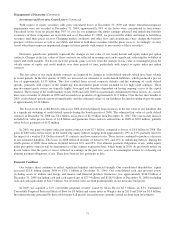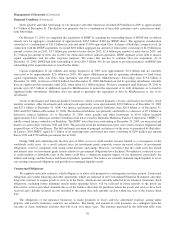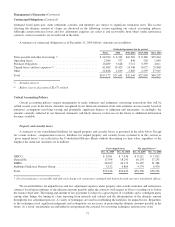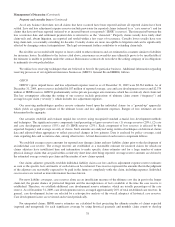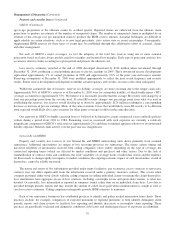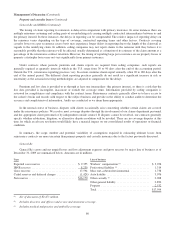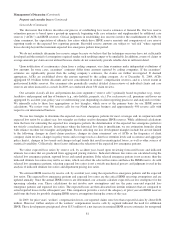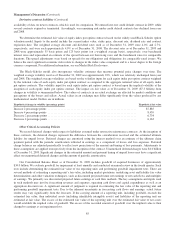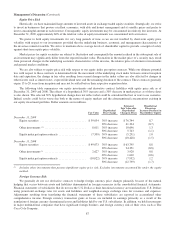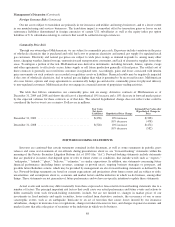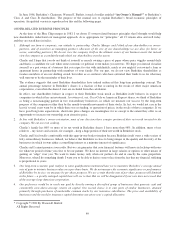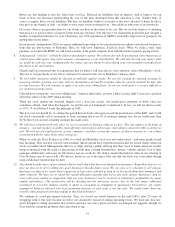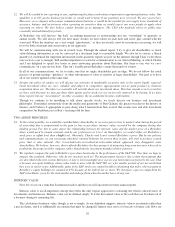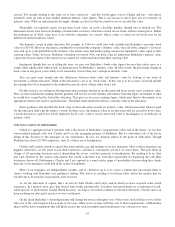Berkshire Hathaway 2009 Annual Report Download - page 85
Download and view the complete annual report
Please find page 85 of the 2009 Berkshire Hathaway annual report below. You can navigate through the pages in the report by either clicking on the pages listed below, or by using the keyword search tool below to find specific information within the annual report.
Management’s Discussion (Continued)
Property and casualty losses (Continued)
BHRG
BHRG’s unpaid losses and loss adjustment expenses as of December 31, 2009 are summarized as follows. Amounts are in
millions.
Property Casualty Total
Reported case reserves ........................................................... $1,524 $ 2,669 $ 4,193
IBNR reserves .................................................................. 1,889 4,054 5,943
Retroactive .................................................................... — 17,973 17,973
Gross reserves .................................................................. $3,413 $24,696 28,109
Deferred charges and ceded reserves ................................................ (4,964)
Net reserves .................................................................... $23,145
A discussion of our loss reserve estimation processes used by our BHRG underwriting unit follows. In general, the
methodologies we use to establish loss reserves vary widely and encompass many of the common methodologies employed in
the actuarial field today. Certain traditional methodologies such as paid and incurred loss development techniques, incurred and
paid loss Bornhuetter-Ferguson techniques and frequency and severity techniques are utilized as well as ground-up techniques
where appropriate. Additional judgments must also be employed to consider changes in contract conditions and terms as well as
the incidence of litigation or legal and regulatory change.
As of December 31, 2009, our gross loss reserves related to retroactive reinsurance policies were predominantly casualty
losses. Our retroactive policies include excess-of-loss contracts, in which losses (relating to loss events occurring before a specified
date on or before the contract date) above a contractual retention are indemnified or contracts that indemnify all losses paid by the
counterparty after the policy effective date. We paid retroactive reinsurance losses and loss adjustment expenses of $1.1 billion in
2009. The classification “reported case reserves” has no practical analytical value with respect to retroactive policies since the
amount is often derived from reports in bulk from ceding companies, who may have inconsistent definitions of “case reserves.” We
review and establish loss reserve estimates, including estimates of IBNR reserves, in the aggregate by contract.
In establishing retroactive reinsurance reserves, we often analyze historical aggregate loss payment patterns and project
losses into the future under various scenarios. The claim-tail is expected to be very long for many policies and may last several
decades. We assign judgmental probability factors to these aggregate loss payment scenarios and an expectancy outcome is
determined. We monitor claim payment activity and review ceding company reports and other information concerning the
underlying losses. Since the claim-tail is expected to be very long for such contracts, we reassess expected ultimate losses as
significant events related to the underlying losses are reported or revealed during the monitoring and review process. During
2009, retroactive reserves developed upward by approximately $420 million.
Our liabilities for environmental, asbestos, and latent injury losses and loss adjustment expenses are presently concentrated
within retroactive reinsurance contracts. Reserves for such losses were approximately $9.1 billion at December 31, 2009 and
$9.2 billion at December 31, 2008. We paid losses in 2009 attributable to these exposures of approximately $600 million.
BHRG, as a reinsurer, does not regularly receive reliable information regarding asbestos, environmental and latent injury claims
from all ceding companies on a consistent basis, particularly with respect to multi-line treaty or aggregate excess-of-loss
policies. Periodically, we conduct a ground-up analysis of the underlying loss data of the reinsured to make an estimate of
ultimate reinsured losses. When detailed loss information is unavailable, our estimates can only be developed by applying recent
industry trends and projections to aggregate client data. Judgments in these areas necessarily include the stability of the legal
and regulatory environment under which these claims will be adjudicated. Potential legal reform and legislation could also have
a significant impact on establishing loss reserves for mass tort claims in the future.
The maximum losses payable under our retroactive policies are not expected to exceed approximately $29 billion as of
December 31, 2009. Absent significant judicial or legislative changes affecting asbestos, environmental or latent injury
exposures, we currently believe it unlikely that unpaid losses as of December 31, 2009 ($18.0 billion) will develop upward to
the maximum loss payable or downward by more than 15%.
83




